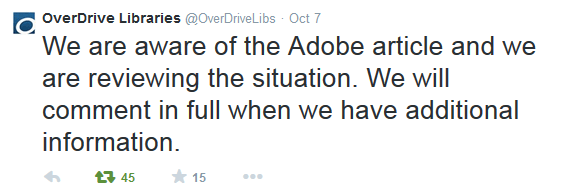The good news: E-books are available to library users in most places for free (well, you know, taxes, but only a very tiny amount of the taxes you pay actually go to supporting the library [PDF]. We do a lot with a little).
The other news: E-books are still mostly only available to one person at a time (the “one copy, one user” model); the physical restrictions of print books are artificially imposed on e-books, despite the fact that the technological capability exists for an unlimited number of people to read an e-book at one time (the “simultaneous use” model). To enforce the 1C1U model, e-books come wrapped in Digital Rights Management (DRM) technology; enter private, third-party vendors in all their clunky, privacy-invading glory.
But at least e-books are cheap, right? Not to libraries, they aren’t. While consumers often see deals on e-books, and prices are generally lower than print books, libraries get gouged. Depending on the publisher’s model (see below), prices for a single 1C1U book may be as high as $90.
A note: I appreciate that publishers are dipping their toes into strange and scary waters with the whole e-book thing, and that no transition is without hiccups. I also believe that books have value, whether they’re printed on paper or in e-ink; what you’re paying for isn’t the dead tree matter, but the work of the author and editor, as well as the other services publishers provide, like publicity, marketing, and distribution.
On the other hand, it would be nice if publishers, in turn, recognized libraries’ role in the book ecosystem: we are both customers (there are more libraries in the U.S. than McDonalds, and we buy a lot of books) and promoters. Readers discover new books and authors at the library, and often go on to purchase those books.
Publishers and libraries share the goal of getting books into readers’ hands, or onto their e-readers. But it can be frustrating for librarians to buy e-books for their libraries, not least because every publisher has a different set of lending rules. In Overdrive, for example – the third-party e-book vendor that the Minuteman Library Network uses – here’s what we’ve got from the “Big Six” publishers (Penguin and Random House have merged, but still retain different models), all of which only offer the 1C1U model:
HarperCollins: 26 checkouts, then the book expires and needs to be “purchased” (licensed) all over again.
Penguin: 1 year of unlimited downloads (“unlimited” in the sense that there isn’t a 26-checkout cap like HC, but it’s still a 1C1U model)
Random House: Books do not expire, but are very expensive.
Macmillan: 2 years or 52 checkouts, whichever comes first. Previously, Macmillan would only sell to individual libraries, but recently they have made their titles available to consortia.
Hachette: Books do not expire, but are only available to individual libraries, not consortia.
Simon & Schuster: 1 year, and requires the added “feature” of a “Buy It Now”* button, so readers who don’t want to wait in line for the e-book from the library can choose to buy it from another service instead.
*The add-BIN-or-no-books-for-you blackmail was not received well at all by librarians. Personally, I am much more concerned about Amazon collecting reading data from Kindle users, and Adobe collecting data from everyone; it’s an invasion of privacy with no choice to opt out, whereas the BIN button does not cause users to purchase a book accidentally if they only mean to borrow. Protecting patrons’ privacy and confidentiality is a core value of librarianship.
Another core value is resource sharing, which makes some publishers’ refusal to sell to consortia particularly aggravating. (The books are the same price regardless.) Being part of a larger network of libraries offers tremendous advantages to the people we serve. It allows libraries to specialize somewhat, by developing a foreign language collection, for example, and eases some of the “a lot with a little” burden. (Academic libraries face the problem of not being able to share digital materials because of publisher and vendor restrictions as well, which is a threat to the InterLibrary Loan (ILL) system on which they rely.)
So that’s a little snapshot of where we are now, at least those of us using Overdrive as a vendor. There are those who are trying to break out of this mold (e.g. the Douglas County Libraries, and now the Massachusetts State E-book Project), and their efforts are admirable, especially considering the significant hurdles they face. It may be a brave new world, but it has librarians in it.





















